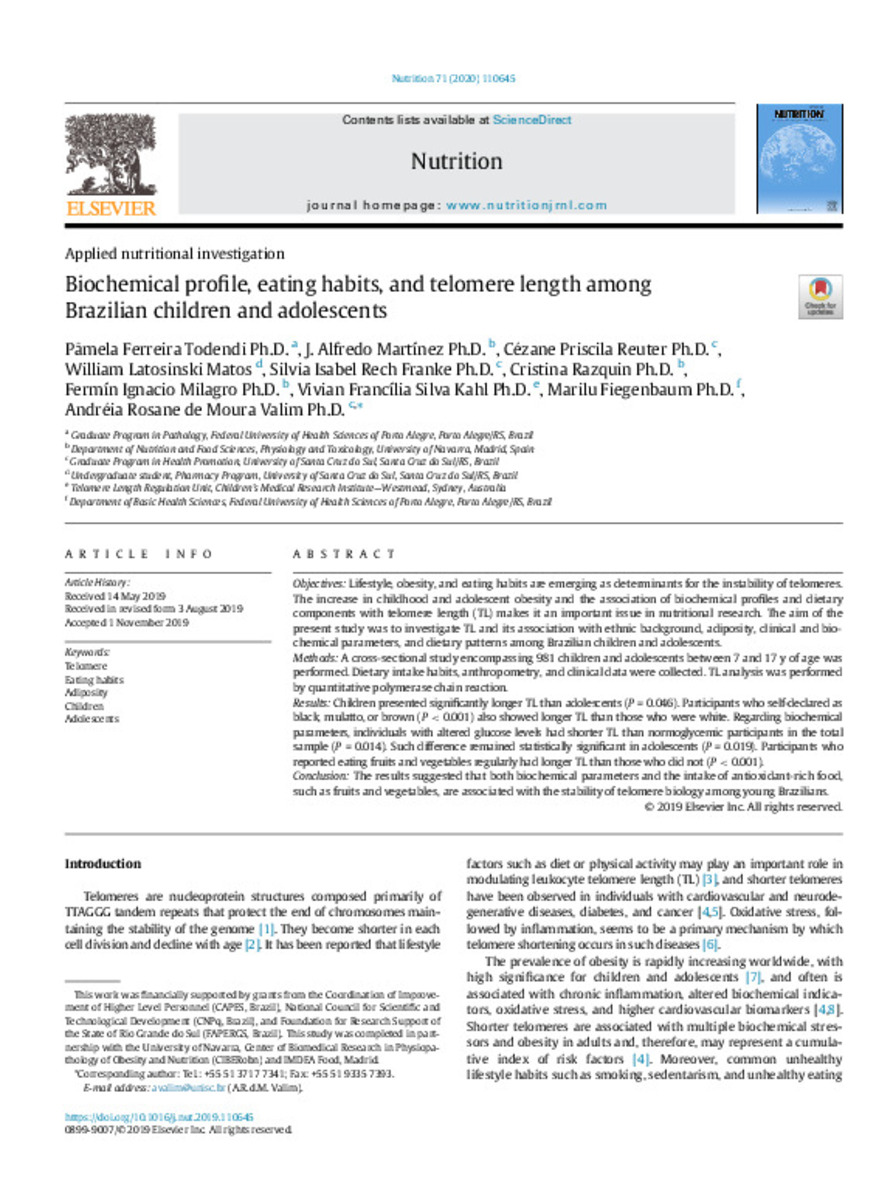Full metadata record
| DC Field | Value | Language |
|---|---|---|
| dc.creator | Ferreira-Todendi, P. (Pamela) | - |
| dc.creator | Martinez, J.A. (José Alfredo) | - |
| dc.creator | Priscila-Reuter, C. (Cezane) | - |
| dc.creator | Latosinski-Matos, W. (William) | - |
| dc.creator | Rech-Franke, S.I. (Silvia Isabel) | - |
| dc.creator | Razquin, C. (Cristina) | - |
| dc.creator | Milagro-Yoldi, F.I. (Fermín Ignacio) | - |
| dc.creator | Silva-Kahl, V.F. (Vivian Francilia) | - |
| dc.creator | Fiegenbaum, M. (Marilu) | - |
| dc.creator | Moura-Valim, A.R. (Andreia Rosane) de | - |
| dc.date.accessioned | 2023-04-20T11:50:06Z | - |
| dc.date.available | 2023-04-20T11:50:06Z | - |
| dc.date.issued | 2020 | - |
| dc.identifier.citation | Ferreira-Todendi, P. (Pamela); Martinez, J.A. (José Alfredo); Priscila-Reuter, C. (Cezane); et al. "Biochemical profile, eating habits, and telomere length among Brazilian children and adolescents". Nutrients. 71, 2020, 110645 | es |
| dc.identifier.issn | 0899-9007 | - |
| dc.identifier.uri | https://hdl.handle.net/10171/66049 | - |
| dc.description.abstract | Objectives: Lifestyle, obesity, and eating habits are emerging as determinants for the instability of telomeres. The increase in childhood and adolescent obesity and the association of biochemical profiles and dietary components with telomere length (TL) makes it an important issue in nutritional research. The aim of the present study was to investigate TL and its association with ethnic background, adiposity, clinical and biochemical parameters, and dietary patterns among Brazilian children and adolescents. Methods: A cross-sectional study encompassing 981 children and adolescents between 7 and 17 y of age was performed. Dietary intake habits, anthropometry, and clinical data were collected. TL analysis was performed by quantitative polymerase chain reaction. Results: Children presented significantly longer TL than adolescents (P = 0.046). Participants who self-declared as black, mulatto, or brown (P < 0.001) also showed longer TL than those who were white. Regarding biochemical parameters, individuals with altered glucose levels had shorter TL than normoglycemic participants in the total sample (P = 0.014). Such difference remained statistically significant in adolescents (P = 0.019). Participants who reported eating fruits and vegetables regularly had longer TL than those who did not (P < 0.001). Conclusion: The results suggested that both biochemical parameters and the intake of antioxidant-rich food, such as fruits and vegetables, are associated with the stability of telomere biology among young Brazilians. | es_ES |
| dc.language.iso | eng | es_ES |
| dc.publisher | Elsevier | es_ES |
| dc.rights | info:eu-repo/semantics/openAccess | es_ES |
| dc.subject | Telomere | es_ES |
| dc.subject | Eating habits | es_ES |
| dc.subject | Adiposity | es_ES |
| dc.subject | Children | es_ES |
| dc.subject | Adolescents | es_ES |
| dc.title | Biochemical profile, eating habits, and telomere length among Brazilian children and adolescents | es_ES |
| dc.type | info:eu-repo/semantics/article | es_ES |
| dc.identifier.doi | 10.1016/j.nut.2019.110645 | - |
| dadun.citation.publicationName | Nutrients | es_ES |
| dadun.citation.startingPage | 110645 | es_ES |
| dadun.citation.volume | 71 | es_ES |
Files in This Item:
Statistics and impact
Items in Dadun are protected by copyright, with all rights reserved, unless otherwise indicated.






